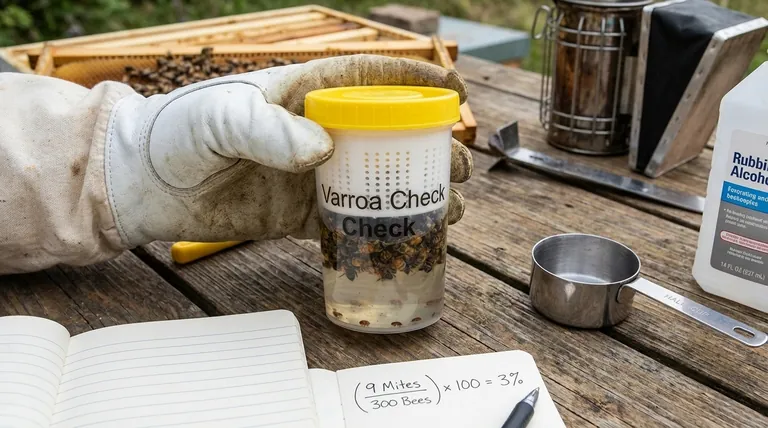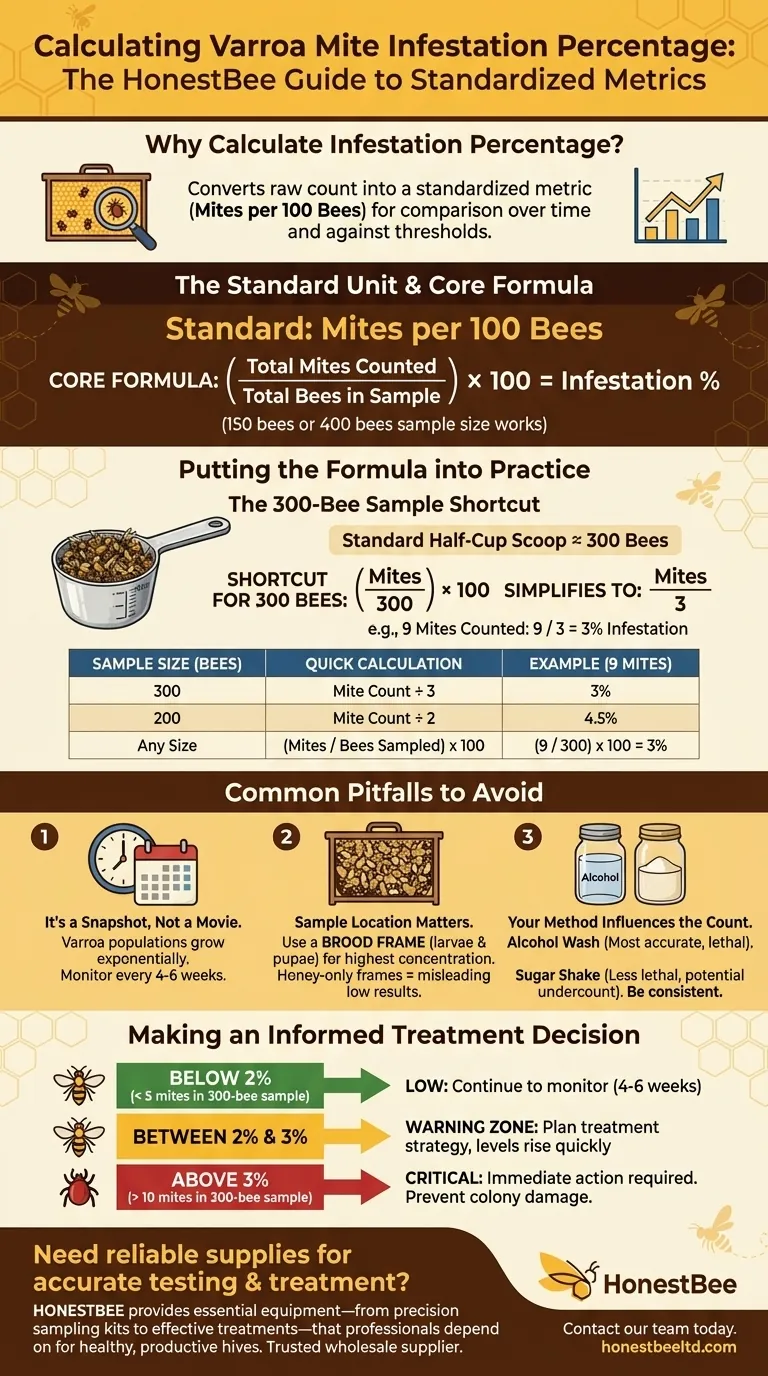To calculate your Varroa mite infestation percentage, you simply convert your mite count into a standard measure of "mites per 100 bees." For a standard 300-bee sample, divide your mite count by 3. If you used a 200-bee sample, you would divide your mite count by 2.
The goal is not just to get a number, but to get a standardized metric. This percentage allows you to compare your hive's health over time and against established treatment thresholds, turning a simple count into an actionable management tool.

Why We Calculate Infestation Percentage
A raw count of mites is not useful on its own. Finding 12 mites in a sample is alarming if you only sampled 100 bees, but less so if you sampled 500. Calculating a percentage standardizes your result, giving you a clear and comparable data point.
The Standard Unit: Mites per 100 Bees
The beekeeping industry standard is to express mite levels as the number of mites per 100 bees. This allows for consistent tracking, clear communication with other beekeepers, and reliable decision-making based on established research.
The Core Formula
The universal formula to calculate your infestation percentage is straightforward:
(Total Mites Counted / Total Bees in Sample) x 100 = Infestation %
This formula works for any sample size, whether you collected 150 bees or 400 bees.
Putting the Formula into Practice
The common advice to "divide by 3" is just a shortcut for the most common sample size.
A standard half-cup measuring scoop holds approximately 300 bees. Using the core formula: (Mites / 300) * 100 simplifies mathematically to Mites / 3. This is why that simple division works so effectively.
Common Pitfalls to Avoid
Calculating the percentage is the easy part. Interpreting it correctly requires understanding its limitations and the context of your sample.
It's a Snapshot, Not a Movie
A single mite count tells you the infestation level on one specific day. Varroa mite populations grow exponentially, so a low count in May can become a dangerously high count by August. Consistent monitoring every 4-6 weeks is critical.
Sample Location Matters
To get the most accurate reading, your bee sample should be taken from a brood frame. Mites reproduce in the brood cells, so frames containing larvae and pupae will have the highest concentration of phoretic mites on adult bees. Sampling from a honey-only frame will give you an artificially low and misleading result.
Your Method Influences the Count
The two most common methods for sampling are the alcohol wash and the powdered sugar shake. Alcohol washes are more accurate and kill the mites and bees. Sugar shakes are less lethal to the bees but are also generally less effective at dislodging every mite, potentially leading to a slight undercount. Be consistent with your chosen method for reliable year-over-year data.
Making an Informed Treatment Decision
Your infestation percentage is the primary indicator for whether intervention is needed. While local conditions and hive genetics can vary, there are widely accepted treatment thresholds.
- If your infestation rate is below 2% (e.g., 5 mites in a 300-bee sample): Your mite level is currently low. Continue to monitor the hive's health and plan for your next test in 4-6 weeks.
- If your infestation rate is between 2% and 3%: This is the warning zone. You should begin planning your treatment strategy, as mite levels can rise quickly from this point, especially in late summer.
- If your infestation rate is above 3% (e.g., 10+ mites in a 300-bee sample): This is a critical level that requires immediate action. Prompt treatment is necessary to prevent significant damage to the colony, especially heading into fall.
Consistent monitoring and accurate calculations are the foundation of proactive and successful hive management.
Summary Table:
| Sample Size (Bees) | Quick Calculation | Example: 9 Mites Counted |
|---|---|---|
| 300 | Mite Count ÷ 3 | 9 ÷ 3 = 3% Infestation |
| 200 | Mite Count ÷ 2 | 9 ÷ 2 = 4.5% Infestation |
| Any Size | (Mites / Bees Sampled) x 100 | (9 / 300) x 100 = 3% |
Need reliable supplies for accurate Varroa mite testing and treatment?
As a trusted wholesale supplier to commercial apiaries and distributors, HONESTBEE provides the essential equipment—from precision sampling kits to effective treatments—that professionals depend on for healthy, productive hives.
Contact our team today to discuss your wholesale needs and ensure your operation is equipped for success.
Visual Guide

Related Products
- Varroa Easy Check Mite Tester Kit Counter Alcohol Wash Jar
- HONESTBEE Wooden Bee Escape Board with Triangle Mesh Design for Beekeeping
- Langstroth Screen Bottom Board for Beekeeping Wholesale
- High-Efficiency Diamond Maze Bee Escape for Clearing Supers
- HONESTBEE Multi Exit Plastic Bee Escape Board for Efficient Honey Harvesting
People Also Ask
- How often should varroa mite checks be performed using the alcohol wash method? Optimize Your Apiary's Health
- What is the Varroa EasyCheck and its purpose? Streamline Your Hive Health Monitoring
- What is the most reliable method for assessing Varroa mite infestations? Master Proactive Hive Management
- What are the steps to perform an alcohol wash test after collecting the bees? A Guide to Accurate Varroa Mite Counting
- What are some popular methods to measure Varroa mite load in beehives? Compare Accuracy & Bee Safety



















